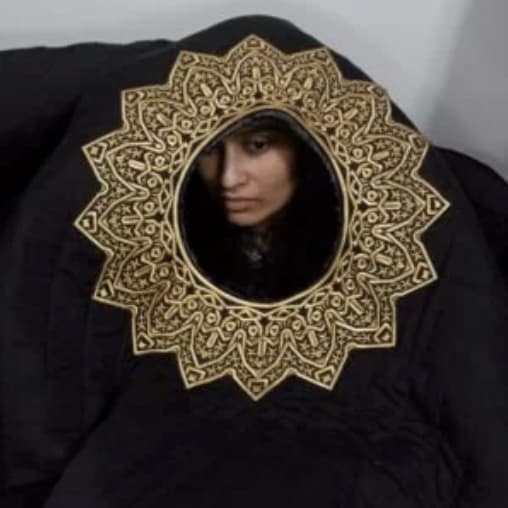Baseera Khan: Cloak and Dagger
The Maria & Alberto de la Cruz Art Gallery at Georgetown University is pleased to present a collaboration with the artist Baseera Khan (American, b. 1980; lives Brooklyn). Khan works across several creative platforms to explore and represent one intersectional Muslim Femme experience.
Baseera Khan: Cloak and Dagger continues an academic year devoted to exhibitions and programs featuring women-aligned artists. Khan describes themself as “a feminist,” and a “Brown American Muslim whose theological upbringing is native to being American.” As a child of Indian-Iranian, Afghani, and East African heritage, Khan has found ways to navigate complicated and unmoored identities. Their work is informed by family histories of immigration and fear of threats of separation, deportation, and dislocation in Texas. However, Khan also shares the rich visual pleasures and desires of their culture and personal experience by creating a tension between lived encounters with exile and kinship, and prejudice and joyful personal exploration.
This exhibition is generously supported by Maria & Alberto de la Cruz. Curated by Al Miner.
-
 Baseera KhanColumn 2, 2019Pink Panther foamular, plywood, resin dye, custom handmade silk rugs made in Kashmir2 × 24 ½ × 72 inches
Baseera KhanColumn 2, 2019Pink Panther foamular, plywood, resin dye, custom handmade silk rugs made in Kashmir2 × 24 ½ × 72 inches -
 Baseera KhanEarrings with Attached Headdress Pink, from Law of Antiquities, 2021Archival C-print, artist’s custom frame20 × 16 inches
Baseera KhanEarrings with Attached Headdress Pink, from Law of Antiquities, 2021Archival C-print, artist’s custom frame20 × 16 inches -
 Baseera KhanI Arrive in Place with a High Level of Psychic Distress (Orange), 2021Archival inkjet print, laser-cut acrylic, maple wood spacers.62 × 37 inches
Baseera KhanI Arrive in Place with a High Level of Psychic Distress (Orange), 2021Archival inkjet print, laser-cut acrylic, maple wood spacers.62 × 37 inches
-

Baseera Khan and Mecca Jamilah Sullivan
February 8, 2023February 8, 2023 4:30 P.M. Maria & Alberto de la Cruz Art Gallery Join artist Baseera Khan and author Mecca Jamilah Sullivan for a conversation...Read more -

Baseera Khan: Opening Reception and Performance
January 19, 2023January 19, 2023 6:00 - 8:00 P.M. Maria & Alberto de la Cruz Art Gallery Join us to celebrate the opening of our spring exhibition,...Read more
explore and represent one intersectional Muslim Femme experience. Khan describes themself
as “a feminist,” and a “Brown American Muslim whose theological upbringing is native to being American.” As a child of Indian-Iranian, Afghani, and East African heritage, Khan has found ways to navigate complicated and unmoored identities. Their work is informed by family histories of immigration and fear of threats of separation, deportation, and dislocation in Texas. However, Khan also shares the rich visual pleasures and desires of their culture and personal experience by creating a tension between lived encounters with exile and kinship, and prejudice and joyful personal exploration.





